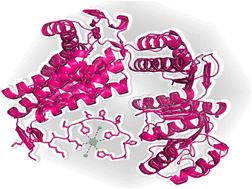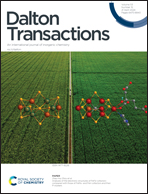Beyond copper: examining the significance of His-mutations in mycobacterial GroEL1 HRCT for Ni(ii) complex stability and formation†
Abstract
Recently, we have studied the coordination chemistry of the Cu(II)–histidine-rich C-terminal tail (HRCT) complex of the mycobacterial GroEL1 protein. The structure of this domain differs significantly compared to the well-known methionine-glycine-rich GroEL chaperonin – it was predicted that mycobacterial GroEL1 could play a significant role in the metal homeostasis of Mycobacteria, especially copper. However, we found that this particular domain's pattern also repeats in a number of Ni(II)-binding proteins. Here, we present the studies concerning the properties of GroEL1 HRCT as a ligand for Ni(II) ions. For this purpose, we chose eight model peptides: L1 – Ac-DHDHHHGHAH, L2 – Ac-DKPAKAEDHDHHHGHAH, and 6 mutants of the latter in the pH range of 2–11. We examined the stoichiometry, stability, and spectroscopic features of copper complexes. We noticed that similar to the Cu(II)-complex, the presence of a Lys5 residue significantly increases the stability of the system. The impact of His mutations was also examined and carefully studied using NMR spectroscopy. His9 and His13 are the crucial residues for Ni(II) binding, whereas His12 has minimal relevance in complex formation.



 Please wait while we load your content...
Please wait while we load your content...